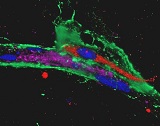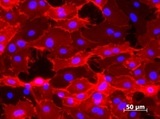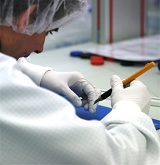Matrix tissue interaction

The overall objective of this WP is to achieve a detailed understanding of characteristics and functions of vascular cells in contact with novel materials to optimise the establishment of composite vascular systems. This includes the interaction of perivascular cells, with endothelial cells and the underlying ECM. Additionally the interaction between adipocytes and electrospun or biological matrices will be investigated.
The vasculature is characterised by a composite structure of functionally distinct cells like Pericytes (PC) and Endothelial cells (EC) in the vessel wall, specialised extracellular matrix (ECM) layers (vascular basement membrane, interstitial matrix) and contacts with surrounding tissues. This WP will define effects of novel materials on the phenotype, behaviour and receptor-mediated signaling of vascular cells with a focus on perivascular and endothelial cells to improve maturation and stability of engineered vascular structures. In parallel adipocyte interactions with electrospun and biological scaffold materials is analysed.
The Partners of this WP are the Fraunhofer Institute for Laser Technology, University of East Anglia, Innovent-Jena e.V., Medical University of Vienna, University Hospital Bergmannsheil, the University of Stuttgart and Beiersdorf AG.
 Fraunhofer Institute for Laser Technology ILT
Fraunhofer Institute for Laser Technology ILT
